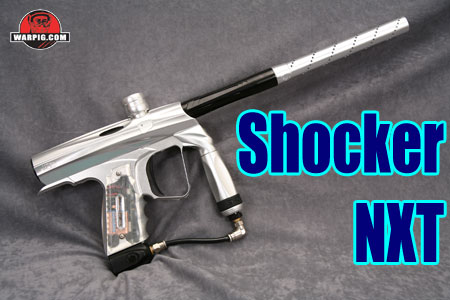
Shocker NXT
by Bill Mills - Photos by Dawn Mills - Aug 2007
Features HowItWorks Disassembly Adjustment Testing Data
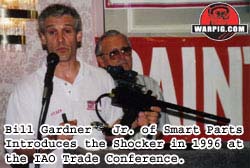 The Shocker has a very long history as an electropneumatic marker. In 1996 it was introduced to the paintball media at the International Amateur Open paintball industry conference. That first Shocker, manufactured by PneuVentures, Inc. (PVI) and marketed in a partnership with Smart Parts, Inc., was a far cry from what people know today as a Shocker. With a limited rate of fire, dual solenoid closed bolt operation, a stamped metal trigger and a bulky body, the PVI Shockers were later replaced by the Shocker Sport, an update to the design produced in-house at Smart Parts. As paintguns progressed, the 11.2 bps rate of fire the Shocker Sport faced due to gas flow limitations, the Shocker Sport lost ground to the lighter and faster Impulse as Smart Parts' flagship marker.
The Shocker has a very long history as an electropneumatic marker. In 1996 it was introduced to the paintball media at the International Amateur Open paintball industry conference. That first Shocker, manufactured by PneuVentures, Inc. (PVI) and marketed in a partnership with Smart Parts, Inc., was a far cry from what people know today as a Shocker. With a limited rate of fire, dual solenoid closed bolt operation, a stamped metal trigger and a bulky body, the PVI Shockers were later replaced by the Shocker Sport, an update to the design produced in-house at Smart Parts. As paintguns progressed, the 11.2 bps rate of fire the Shocker Sport faced due to gas flow limitations, the Shocker Sport lost ground to the lighter and faster Impulse as Smart Parts' flagship marker.
The Shocker Sport picked up nicknames like “shoebox” because of its bulky and boxy shape. That all changed in 2003 when Smart Parts unveiled the next generation of the Shocker – the Shocker SFT – often referred to as the 03 Shocker due to its year of release, though that was not its official name. The Shocker SFT beat both the Impulse and the Shocker Sport in terms of compact size, rate of fire, and minimal weight, and has definitely risen to prominence, it was the marker used by the teams that won the 2003 NXL, 2004 NXL, 2006 NXL, 2004 NPPL, 2005 NPPL and 2006 NPPL national championships. The Shocker SFT is a single tube body design with a spool valve at its center. The bolt forms the spool of the valve, both chambering the paintball and releasing the exhaust gas, its position controlled by small amounts of gas directed by a single solenoid valve. It fires from an open-bolt position.

In 2006, the Shocker SFT got a make-over. Several design changes saw their way first into the private label Shockers used by Smart Parts sponsored teams, like the Naughty Dogs Shocker and Dynasty Shocker. These then appeared as standard on the Shocker NXT which made its debut at the 2006 PSP Mid Atlantic Open.
The Shocker NXT retains the low operating pressure that has been a marketing point of the entire Shocker product line – based around the idea that a lower pressure gas supply will be more gentle on the paintball. The low pressure requirements (about 200 psi) also mean that the Shocker NXT can use either CO2 or HPA (High Pressure Air) as its power source, and Smart Parts says it can use either, provided the CO2 is anti-siphoned, though most players willing to buy a marker at this price point are also going to opt for the added thermal stability of HPA.
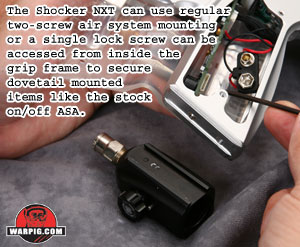 The Shocker NXT ships with a dovetail mounted on/off ASA attached to its grip frame. While the grip frame has a pair of 10/32 industry standard holes for use with other ASAs and drop forwards, it also has a ½-inch dovetail rail milled right into the bottom of the frame.
The Shocker NXT ships with a dovetail mounted on/off ASA attached to its grip frame. While the grip frame has a pair of 10/32 industry standard holes for use with other ASAs and drop forwards, it also has a ½-inch dovetail rail milled right into the bottom of the frame.
The on/off ASA slides into the dovetail and is locked in place by a 10/32 set screw accessed from inside the frame. Smart Parts' Max-Flo Micro air system as well as other brands of dovetail mount air accessories can mount straight to the frame without need for an adapter rail.
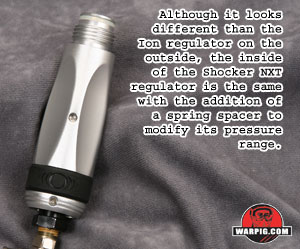 The on/off ASA feeds gas via macroline to the NXT regulator. While the outside of this reg looks new, its internals and adjuster cap at the bottom will be familiar to Ion owners. The internal structure is identical to that of an Ion, with the addition of a spacer, which puts slightly more pressure on the regulator spring, According to Hans Semelsberger in Smart Parts' engineering staff, the regulator originally designed for the Ion had the highest flow rate and consistency of any vertical regulator the company had ever produced, making it a natural performance update to the Shocker.
The on/off ASA feeds gas via macroline to the NXT regulator. While the outside of this reg looks new, its internals and adjuster cap at the bottom will be familiar to Ion owners. The internal structure is identical to that of an Ion, with the addition of a spacer, which puts slightly more pressure on the regulator spring, According to Hans Semelsberger in Smart Parts' engineering staff, the regulator originally designed for the Ion had the highest flow rate and consistency of any vertical regulator the company had ever produced, making it a natural performance update to the Shocker.
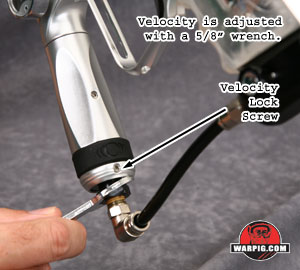 Unlike the Ion, the Shocker NXT does not have a filter screen sitting on top of the regulator. This is because the gas for the Shocker is filtered internally, though a cylindrical filter inside the receiver. The filter is held in place by one of the Shocker's port inserts. These cylinders divide internal gas passages, to route gas within the marker.
Unlike the Ion, the Shocker NXT does not have a filter screen sitting on top of the regulator. This is because the gas for the Shocker is filtered internally, though a cylindrical filter inside the receiver. The filter is held in place by one of the Shocker's port inserts. These cylinders divide internal gas passages, to route gas within the marker.
Rather than a plain regulator body with a polymer cover as is found on the Ion, the NXT regulator is milled aluminum with a rubber strip near the bottom which blocks the regulator's safety screw, a component that needs to be accessed for disassembly. On the lower rim of the regulator is a lock screw, which secures the velocity adjuster to meet field and tournament regulations, much as the optional locking cap does for the Ion.
 The vertical regulator screws into an ASA that moves the reg slightly forward relative to an SFT. This, combined with the fact that the new reg accepts its input at the bottom rather than the side, allows for a complete grip around the reg, with finger space between the reg and trigger guard. Like the older ASA, a low pressure gauge sits in the left side, to monitor operating pressure.
The vertical regulator screws into an ASA that moves the reg slightly forward relative to an SFT. This, combined with the fact that the new reg accepts its input at the bottom rather than the side, allows for a complete grip around the reg, with finger space between the reg and trigger guard. Like the older ASA, a low pressure gauge sits in the left side, to monitor operating pressure.
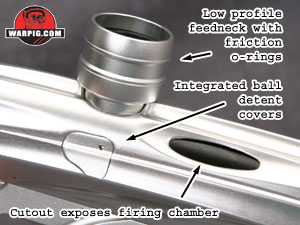 Milling patterns are the first and most obvious difference between the Shocker SFT and NXT. The SFT had a utilitarian shape that got the job done, it contained the internals in a no-frills way. In contrast, the NXT has smooth sweeping lines and contours that are continued in the ASA and the grip frame, as well as a pair of cut-outs that make the contrasting color of the internal firing can visible. This has no real performance aspect, but the reality is that looks are a significant part of many players' decision in buying a marker. The new receiver is also made of a harder grade and finish of aluminum than the Shocker SFT for increased durability.
Milling patterns are the first and most obvious difference between the Shocker SFT and NXT. The SFT had a utilitarian shape that got the job done, it contained the internals in a no-frills way. In contrast, the NXT has smooth sweeping lines and contours that are continued in the ASA and the grip frame, as well as a pair of cut-outs that make the contrasting color of the internal firing can visible. This has no real performance aspect, but the reality is that looks are a significant part of many players' decision in buying a marker. The new receiver is also made of a harder grade and finish of aluminum than the Shocker SFT for increased durability.
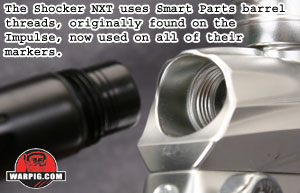 While the receiver works essentially the same way, there are some notable structural changes. Instead of Shocker threads, it utilizes Impulse threads, which are thicker and faster to use less risk of cross-threading. This is brings all of Smart Parts' current markers together. The Ion, SP-8, Epiphany and Shocker NXT all use the same barrel thread. It can also cause confusion though, as a new Shocker NXT owner shopping for barrels will need to ask for a “Smart Parts Thread” or “Impulse Thread” as a “Shocker threaded” barrel will not fit the new Shocker. Some of the private label Shocker NXT markers use different thread choices. The Naughty Dogs version for example is threaded to WGP Autococker standards.
While the receiver works essentially the same way, there are some notable structural changes. Instead of Shocker threads, it utilizes Impulse threads, which are thicker and faster to use less risk of cross-threading. This is brings all of Smart Parts' current markers together. The Ion, SP-8, Epiphany and Shocker NXT all use the same barrel thread. It can also cause confusion though, as a new Shocker NXT owner shopping for barrels will need to ask for a “Smart Parts Thread” or “Impulse Thread” as a “Shocker threaded” barrel will not fit the new Shocker. Some of the private label Shocker NXT markers use different thread choices. The Naughty Dogs version for example is threaded to WGP Autococker standards.
 Threaded into the receiver is a 13.75-inch (Smart Parts calls it 14-inch) All American barrel. The All American is a two-piece barrel, the rear section with heavy milling insets that make it easy to grip and twist while wearing gloves. The front section of the barrel is heavily ported in a dual spiral pattern, and both halves are compatible with Smart Parts' other multi-piece barrel systems like the Freak.
Threaded into the receiver is a 13.75-inch (Smart Parts calls it 14-inch) All American barrel. The All American is a two-piece barrel, the rear section with heavy milling insets that make it easy to grip and twist while wearing gloves. The front section of the barrel is heavily ported in a dual spiral pattern, and both halves are compatible with Smart Parts' other multi-piece barrel systems like the Freak.
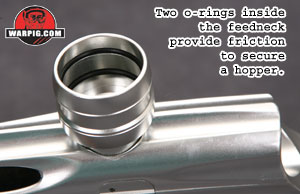 The low-rise feedneck has a pair of internal o-rings to friction fit with a hopper, and fit properly when tested with a variety of brands including HALO, Pulse and VLocity. Players looking to switch to a locking feedneck as an upgrade will also need to be aware that the NXT uses a new thread for its feedneck as well. Shocker SFT feednecks are not compatible. The newer thread has a deeper bite, meant for greater strength against impact during slides and drops.
The low-rise feedneck has a pair of internal o-rings to friction fit with a hopper, and fit properly when tested with a variety of brands including HALO, Pulse and VLocity. Players looking to switch to a locking feedneck as an upgrade will also need to be aware that the NXT uses a new thread for its feedneck as well. Shocker SFT feednecks are not compatible. The newer thread has a deeper bite, meant for greater strength against impact during slides and drops.
On either side of the feedneck are the ball detent covers. This is a significant departure from the Shocker SFT which had a pair of hollow bolts with spring loaded ball bearing style ball detents, and a cover on the right side for a reflective anti-chop eye.
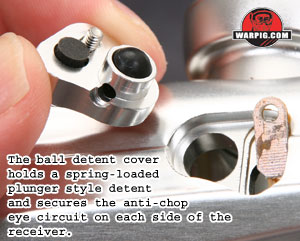 In contrast, the Shocker NXT detents are held in place by contoured covers that blend right into the shape of the body. On each, a small hole provides access for a 0.050-inch hex wrench to get to the head of the screw that secures them. Inside each cover is a spring loaded plunger style ball detent. It presents the same rounded shape inside the breech as a ball-bearing style, but requires less space, because the spring fits inside the plunger. Also, it can not rotate, carrying paint and shell behind it like the ball point of a pen. The ball detent is rebuildable, requiring only a new plunger when worn, rather than having to replace the entire detent assembly.
In contrast, the Shocker NXT detents are held in place by contoured covers that blend right into the shape of the body. On each, a small hole provides access for a 0.050-inch hex wrench to get to the head of the screw that secures them. Inside each cover is a spring loaded plunger style ball detent. It presents the same rounded shape inside the breech as a ball-bearing style, but requires less space, because the spring fits inside the plunger. Also, it can not rotate, carrying paint and shell behind it like the ball point of a pen. The ball detent is rebuildable, requiring only a new plunger when worn, rather than having to replace the entire detent assembly.
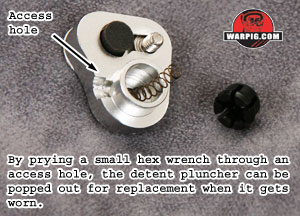 The other major change under the detent covers is in the anti-chop eye system. Smart Parts calls their anti-chop system “Vision.” The Shocker SFT was equipped with reflective vision – a single “eye” on the right side had an infra-red emitter and detector. The circuit board checked how much infra-red light was reflected to determine whether a paintball was in the breech. Since different colored paintball shells reflect light differently, this was occasionally problematic. The NXT in contrast uses a dual “eye” breakbeam Vision system. The emitter sits on one side of the breech and the detector on the other, so that regardless of what color a paintball is (unless it is clear fill in a clear shell) it is going to break the beam as the ball drops between the eyes.
The other major change under the detent covers is in the anti-chop eye system. Smart Parts calls their anti-chop system “Vision.” The Shocker SFT was equipped with reflective vision – a single “eye” on the right side had an infra-red emitter and detector. The circuit board checked how much infra-red light was reflected to determine whether a paintball was in the breech. Since different colored paintball shells reflect light differently, this was occasionally problematic. The NXT in contrast uses a dual “eye” breakbeam Vision system. The emitter sits on one side of the breech and the detector on the other, so that regardless of what color a paintball is (unless it is clear fill in a clear shell) it is going to break the beam as the ball drops between the eyes.
Inside the receiver, the Shocker NXT comes equipped with the Turbo Bolt (the newest name for the High Efficiency Bolt.) This was a common upgrade for Shocker SFT users to improve upon gas efficiency, and it is now included from the factory. The cut-outs in the receiver that show the bolt's firing can do place some limitations on what bolts may be used, as some aftermarket kits have open firing cans which require a fully sealed body.
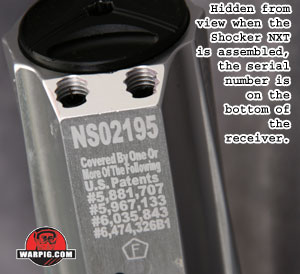 Sticking out the back of the Shocker is a part called the gripper. While it sits in the place of a snatch grip, it is not hooked, and thus serves a basically cosmetic purpose. Beneath the gripper lies the marker's laser engraved serial number and patent information.
Sticking out the back of the Shocker is a part called the gripper. While it sits in the place of a snatch grip, it is not hooked, and thus serves a basically cosmetic purpose. Beneath the gripper lies the marker's laser engraved serial number and patent information.
The NXT grip frame works like that of the SFT, and is compatible, but items such as the trigger are mounted differently. The wraparound rubber grip is held on with hex head screws, instead of Phillips heads, and it contains a Shocker circuit board and 9-volt battery, like the SFT frame. Rather than holding the board in with friction fit pins like the SFT however, the NXT uses pins with hex head screw pins.
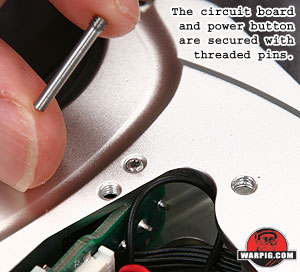 These pins are removed more easily than the old press-in pins, and don't have the problem of becoming lose once removed. The same type of pin is used for the power button pin.
These pins are removed more easily than the old press-in pins, and don't have the problem of becoming lose once removed. The same type of pin is used for the power button pin.
Similarly, the trigger pin is now has a threaded hex head on one end, rather than a pin for the same reasons. A small o-ring even provides friction so that the trigger pin will not unscrew during play (the circuit board pins are secured by the grip when it is closed.)
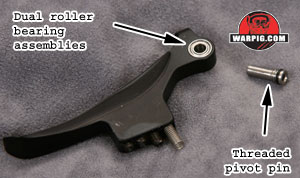 The Shocker NXT trigger has a pair of ball bearing assemblies which allow it to pivot smoothly around its pin with little side to side play. The trigger features four-point adjustment, which is not so unusual in a high-end marker as the fact that all four adjustments can be made with the same size hex-wrench right on the face of the trigger. The trigger does not need to be removed, or the grip opened as with some other designs.
The Shocker NXT trigger has a pair of ball bearing assemblies which allow it to pivot smoothly around its pin with little side to side play. The trigger features four-point adjustment, which is not so unusual in a high-end marker as the fact that all four adjustments can be made with the same size hex-wrench right on the face of the trigger. The trigger does not need to be removed, or the grip opened as with some other designs.
The top trigger adjustment sets trigger resistance. Turning clockwise puts more pressure on the trigger return spring, for a firmer trigger pull, backing it out creates a lighter pull.
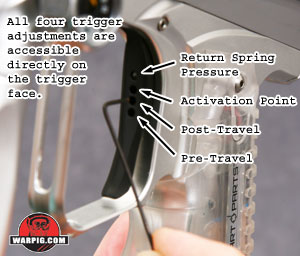 The next adjustment sets the activation point – how far into the trigger pull the microswitch is activated to fire the Shocker NXT. Turning clockwise sets the marker to fire earlier in the trigger pull.
The next adjustment sets the activation point – how far into the trigger pull the microswitch is activated to fire the Shocker NXT. Turning clockwise sets the marker to fire earlier in the trigger pull.
The second screw from the bottom adjusts post travel, or how far back the trigger can swing. Counter-clockwise turning allows the trigger to move back further.
The bottom-most adjustment screw is the pre-travel setting. This setting limits how far forward the trigger can swing. Clockwise adjustment reduces forward swing, while counter-clockwise increases it.
As it shipped stock, the trigger pull was approximately 4mm measured at the tip of the trigger, and was easily trimmed to under 1mm. It should be noted that with full adjustment capabilities on the trigger, care must be taken to make sure that it is the post-travel screw that causes the trigger to stop at the end of a pull. If the post-travel setting is too short, and it is the activation screw pressing deep against the microswitch that stops the trigger, the microswitch and or circuit board can be damaged by hard trigger pulls.
Continue to How It Works .




